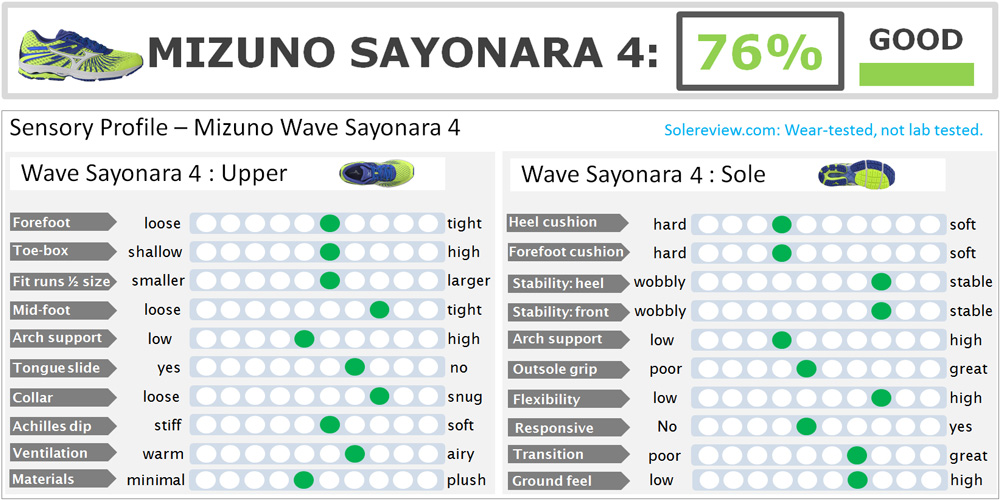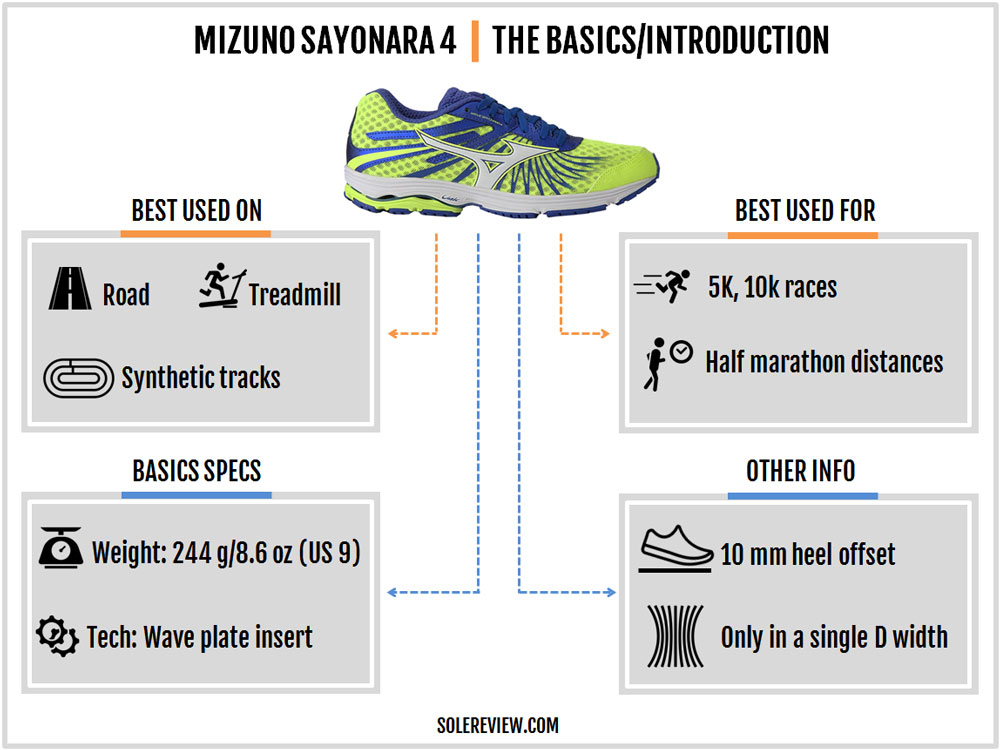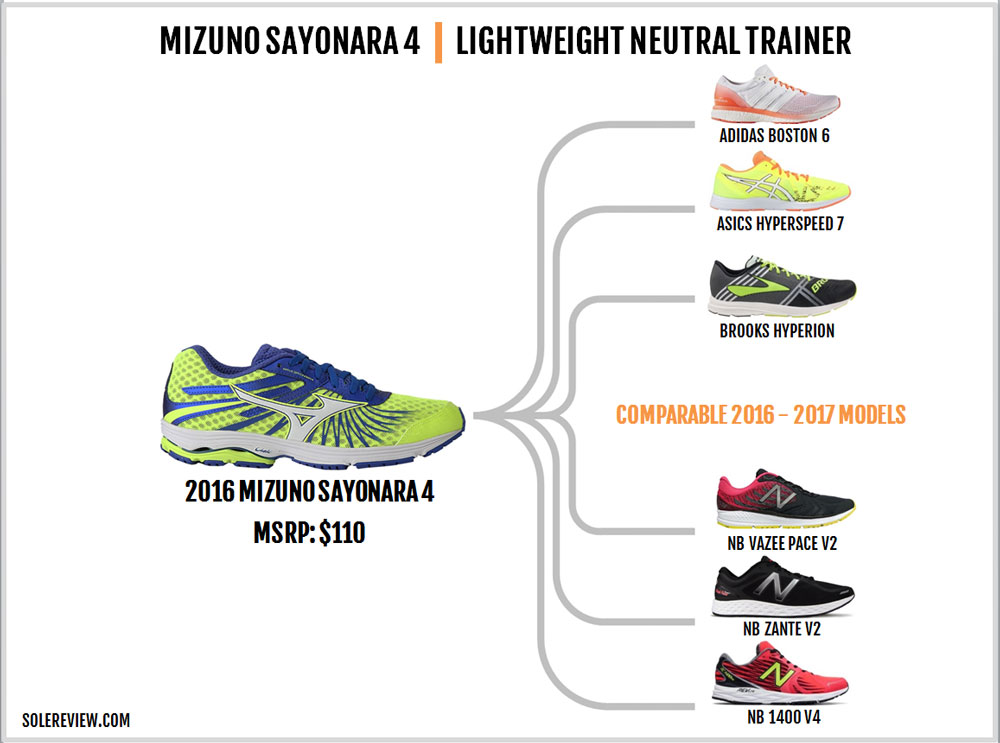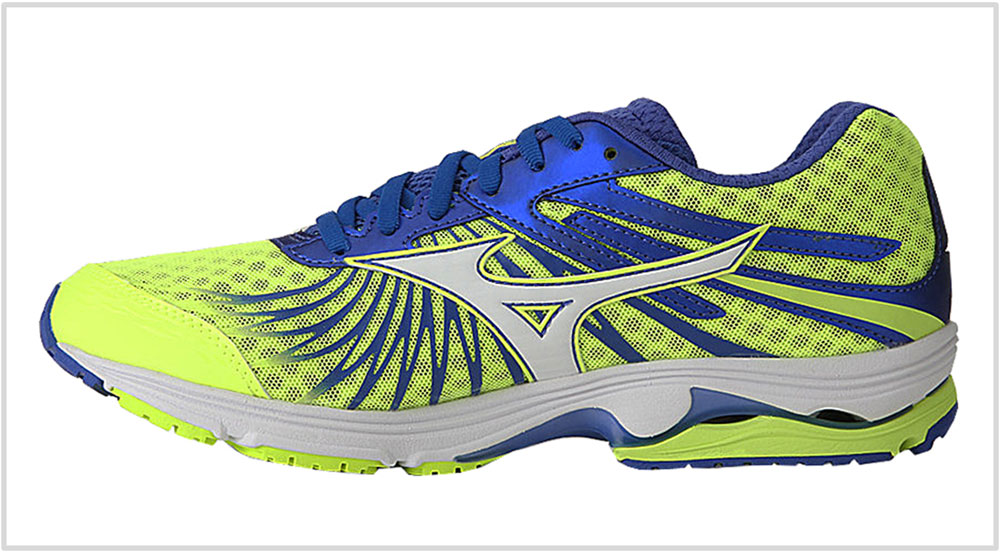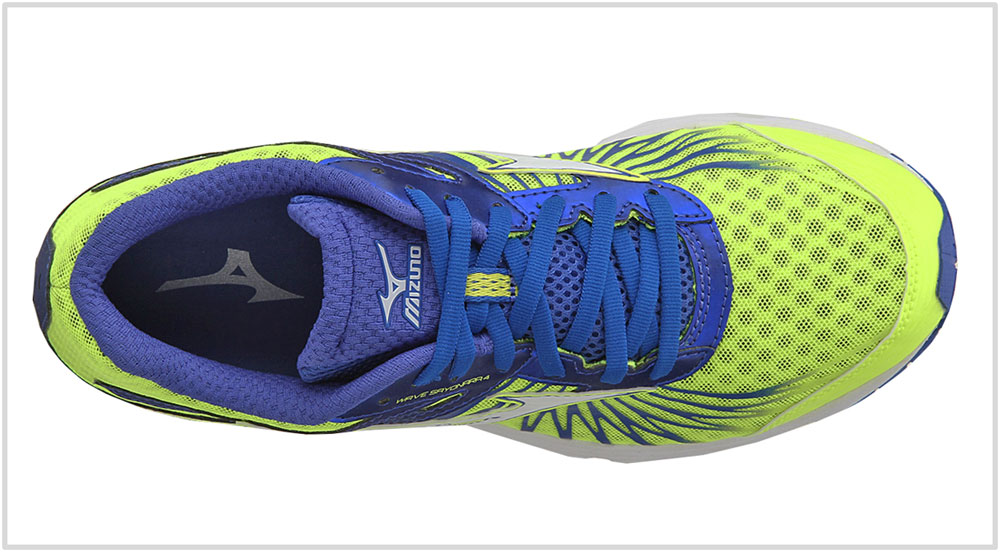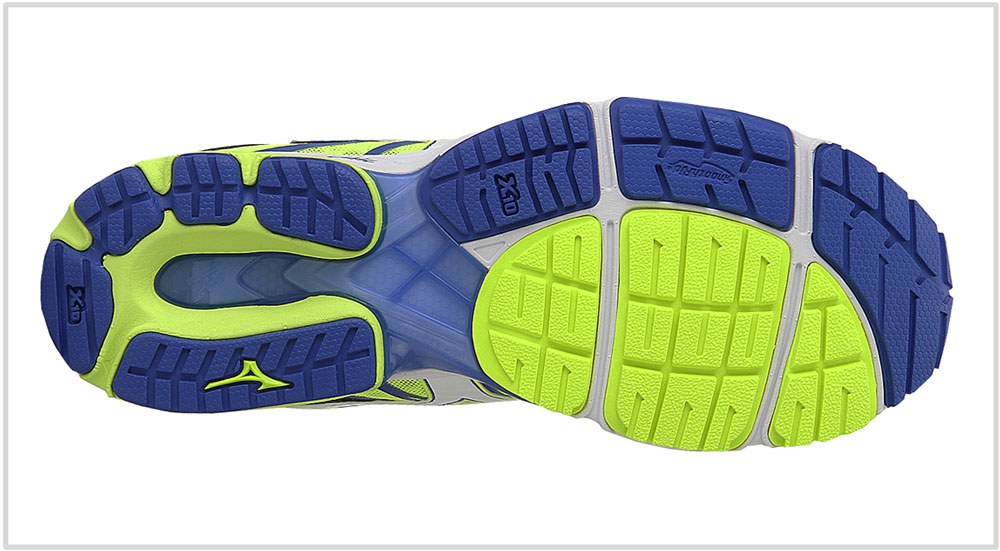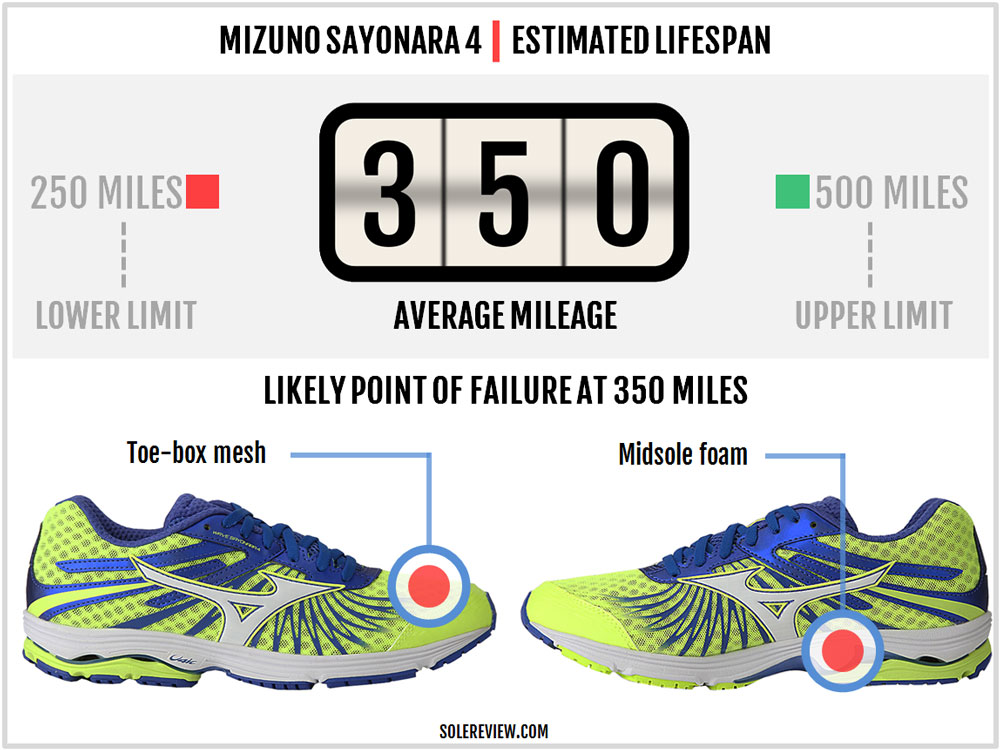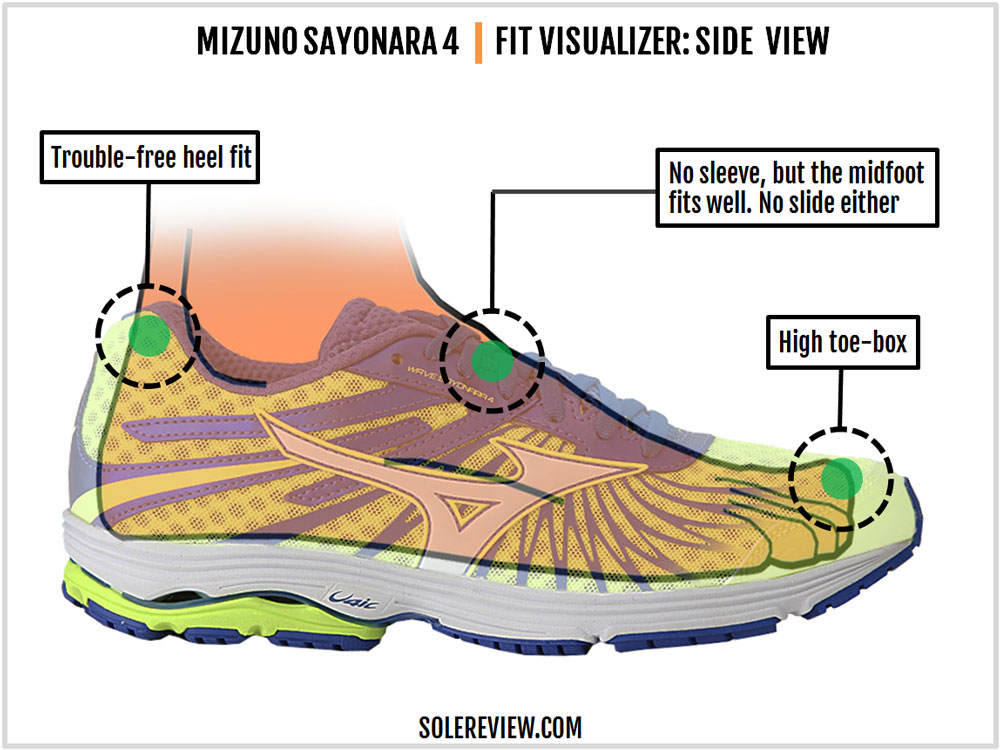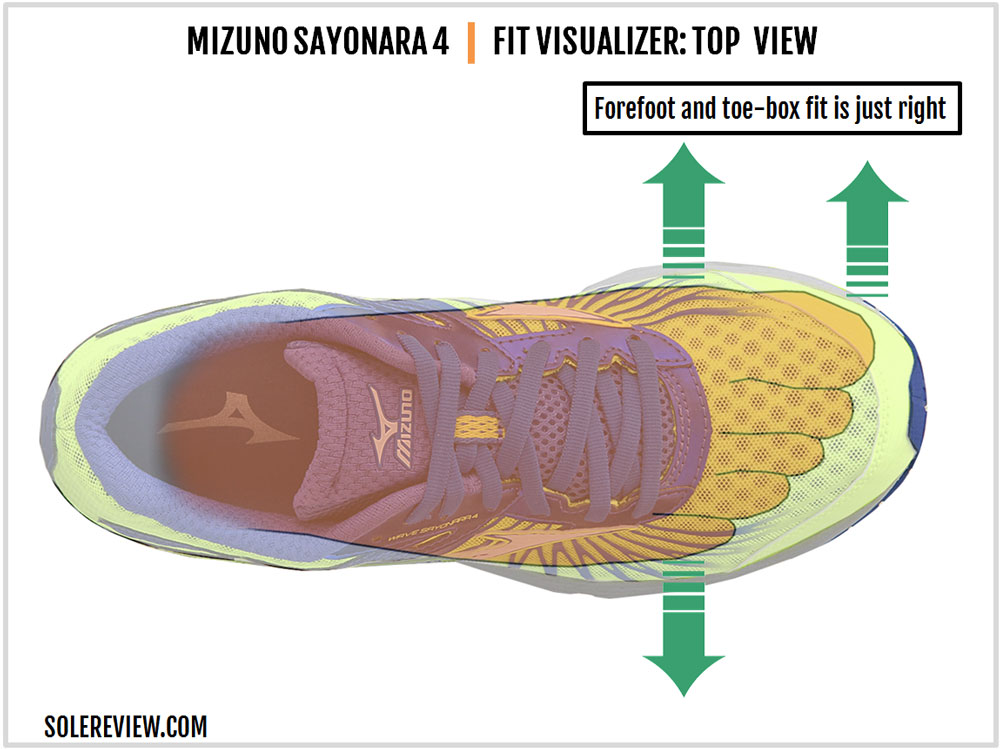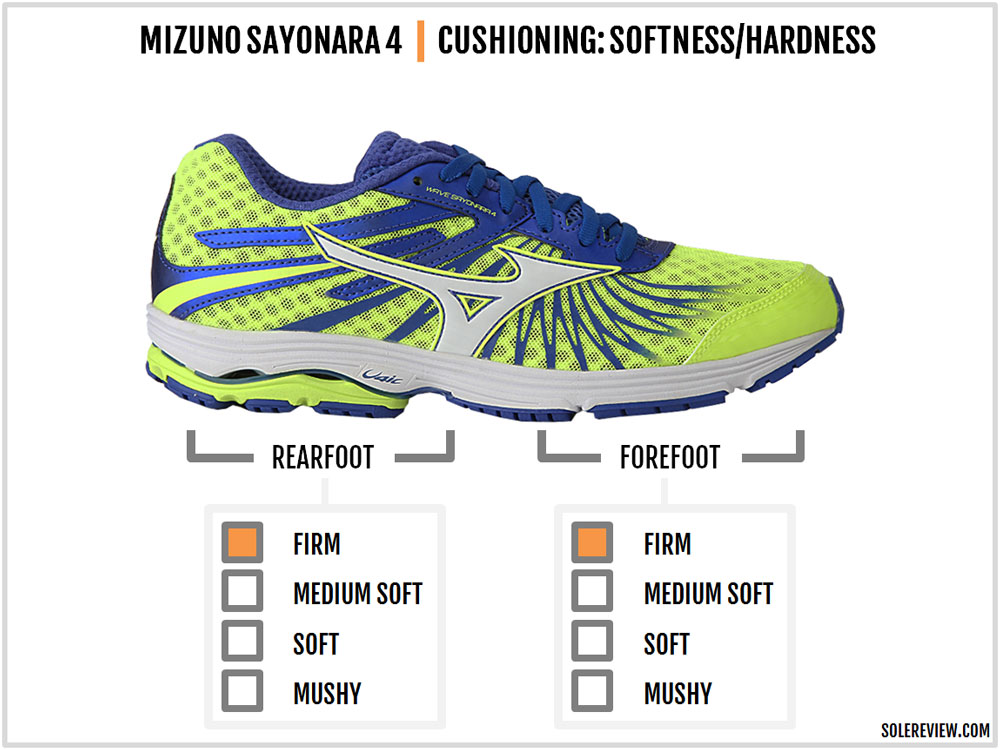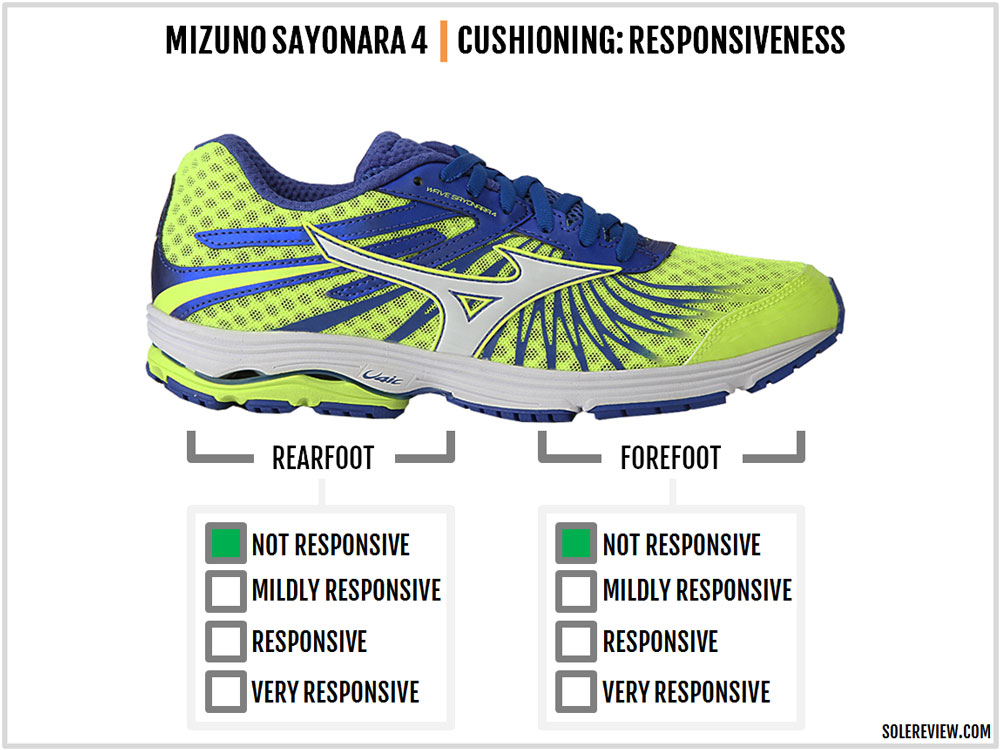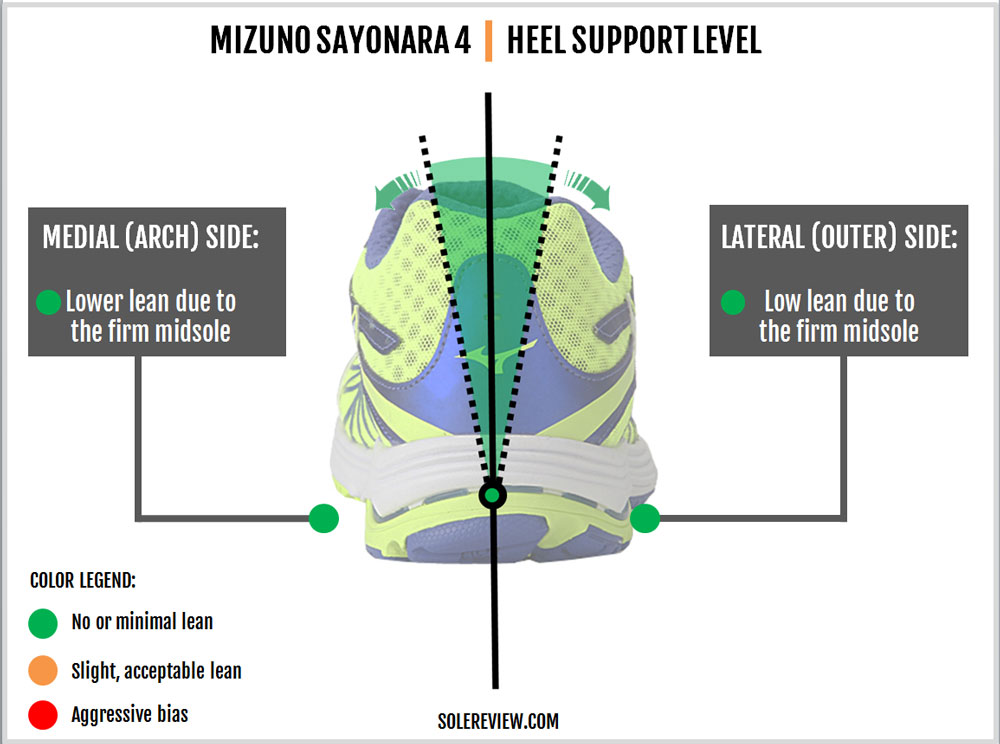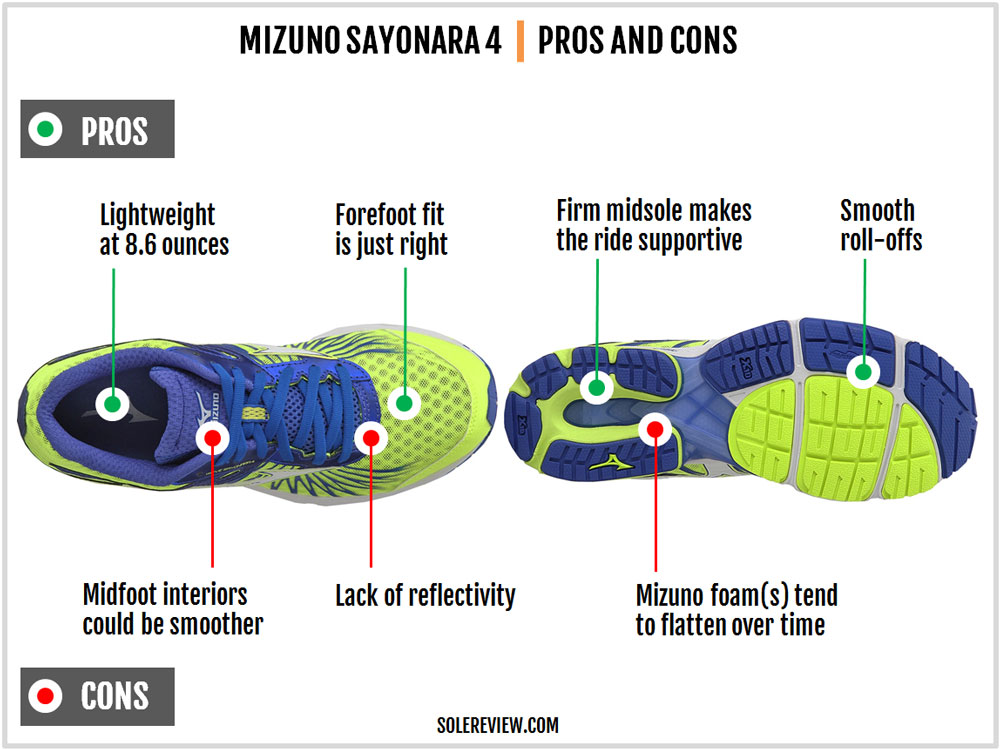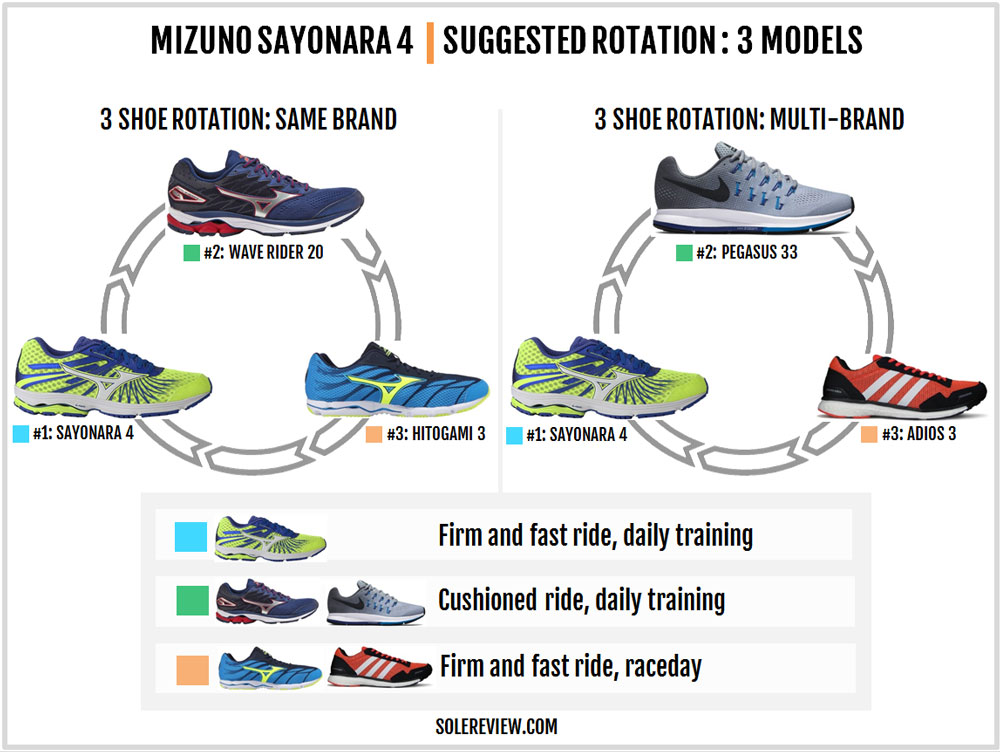INTRODUCTION
For a relatively young product series, the Mizuno Sayonara has sure gone through a lot of changes.
Mizuno, like many others, follows a two-year update cadence for the midsole and outsole design. This means that the Sayonara 1 and 2 shared an identical sole design, and the same applies to the Sayonara 3 and 4.
The midsole and outsole update of the Sayonara 3 brought a drastic evolution of the ride character. The ultra-sharp DSP (Dual Stencil Process) forefoot of the Sayonara 2 was replaced with softer blown-rubber slabs, along with a new insole and a softer midsole.
Overnight, the Sayonara turned from a speed-demon to a cushioned softy. And since the Sayonara 4 carries forward the same sole design from the 3, the ride is very similar. The midsole is slightly firmer, but it doesn’t have a significant effect on the ride behavior.
In our view, the Sayonara 2 best represented what the shoe stood for. It had an upper with all-fused layers, and that was matched with a super-grippy, speed-focused outsole. After all, ‘Sayonara’ is the Japanese word for goodbye, which is a metaphor for leaving the rest of the crowd behind.
We didn’t think very highly of the Sayonara 3. With all the softness-inducing changes, the shoe lost its fast, snappy feel. The S-3’s upper also lacked the seamless feel of the S-2, as the outer and inner upper switched to stitched overlays and inner seams.
The Sayonara 4 brings a few improvements to the upper design. But just know that the newer generation of Sayonara isn’t what it used to be, so manage your expectations if you’re transitioning from the Sayonara 2 or older.
At 8.6 ounces/244 grams, the Mizuno Wave Sayonara 4 is classified as a lightweight trainer meant for fast-paced workouts and races.
Among competing models, the adidas Boston 6 Boost is an identical weight match, albeit with a more cushioned and responsive ride. The Boston also uses a lot of rubber for its outsole, so shoe to shoe, the Sayonara and Boston are a match on a couple of aspects.
You can also add the Brooks Hyperion, Asics Hyperspeed, and the New Balance Fresh Foam Zante to this category. The Hyperion is a firm shoe, whereas the Hyperspeed and the Zante have a medium-soft ride.
We’d also have thrown the Vazee 2090 into this mix because of its ride similarity (to the Sayonara), but then the 2090 has an up-in-the-clouds retail price of $150.
DESIGN AND MATERIALS
For those of you who hoped that the Sayonara 4’s upper would revert to a completely no-sew design (like the V2), there’s some good news and some bad news. The good news is that the forefoot uses welded overlays which replace the strange inner straps of the Sayonara 3.
The not-so-good news is that the Mizuno logos stayed stitched on the sides, which means that there’s a seam inside. The toe-bumper remains a stitched-over component, and that does no harm. If anything, it contributes to the toe-box room.
The Sayonara 4’s upper looks much cleaner because of the single type of mesh used all over. This doesn’t mean that the upper is made of a one-piece mesh; there is a seam under the Mizuno logo which joins the front and rear portions together. Over the midfoot and heel, there are decorative strips stitched over.
In what’s an unexpected development, both the tongue and heel lining use a brand new mesh – a material which is not used elsewhere in Mizuno’s current line-up. If you’re familiar with Mizuno, then you’d also be familiar with the lining they use. Nearly all the models have thus used a similar kind of material on the heel and the tongue.
The Sayonara 4 bucks convention, and replaces the long-used mesh with a new lining material which has a different texture. It still stays soft and is backed by a medium level of foam filling. The tongue is not attached to a sleeve, but the ultra-wide flap prevents it from sliding around. The flat, semi-stretch laces are the same which were used on the S-3.
Reflectivity is never a priority on Mizuno running shoes; the Sayonara 4 gets a token presence in the form of tiny reflective slits over the heel.
There’s been no change in the midsole and outsole design over the Sayonara 3, except for the slightly firmer density of foam used. Otherwise, you’ll see the same dual-density midsole with the Wave plate sandwiched in between. The crash pad under the heel is of a different density than the main midsole, regardless of the same color.
In our S-3 review, we covered the changes of the Wave Plate design (vs. the S-2) in detail. By making the curves of the plastic plate milder on the outer side, the Sayonara 3’s Wave became easier to compress. The Sayonara 4 features the same (modified) Wave plate design.
The outsole has wide slabs of cushiony blown rubber under the forefoot and a much harder X-10 rubber in the back. The Wave plate also serves as the plastic shank which wraps the midsole waist. The forefoot comes with dual flex grooves, which makes the Sayonara 4 very flexible.
Compared to the DSP outsole design, the Sayonara 4 (and 3) provides lower forefoot grip. This update makes the new model more road-biased; if you run on synthetic tracks, you’ll miss the sharp hold of the prior Sayonara versions.
Inside the shoe, Mizuno uses the same S-3 insole. The top fabric has a premium hand-feel, and it covers a layer of soft blown foam. Till the Sayonara 2, the insole was made of a firmer compression molded foam. Switching to the new design on the Sayo-3 was partly responsible for making the latter’s ride softer than the Sayo-2.
The Sayonara is prone to a couple of Mizuno quirks. The EVA used in Mizuno midsoles tend to go flat after a few hundred miles, even if the outsole holds up well.
Expect the forefoot mesh to last around 350 miles, after which wear and tear will kick in. Usually, the first part to go is the area where the mesh and synthetic toe-bumper meet.
UPPER FIT AND FEEL
Mizuno running shoes have never been found wanting for toe-box space, so the Sayonara 4 provides plenty of room inside. The stitched toe-bumper delivers enough vertical space.
We’re not quite sure what prompted Mizuno to ditch the Sayonara 2’s no-sew design on the V3 and V4. The stitched logos on the S-4’s midfoot creates an inner seam inside, which results in a band-like feel around the midfoot. This also means that you can’t run in the Sayonara 4 barefoot too. The midfoot fit isn’t uncomfortable, but it could have been much better considering the Sayonara 2 experience.
The broad tongue feels slightly more ‘athletic’ than the last version, a feel which can be attributed to the change in lining material and construction.
The heel pads better around the ankles, as the collar has an increased amount of foam over the Sayonara 3.
The Sayonara 3 had unusual looking straps underneath the forefoot mesh. Thankfully, the S-4 trades that for a smoother interior and fused overlays. Hence, the interiors feel smooth in the forefoot.
As with most Mizuno models, the toe area has a broad profile. It also helps that the latest Sayonara’s toe-bumper is a bit higher (than the V3) on the medial side – an update which creates room on the big-toe side.
RIDE QUALITY AND BEHAVIOR
Depending on your perspective, the Sayonara 4 can be either soft or firm If you’re comparing the Sayonara 4 to the Sayonara 3, then the 4 is marginally firmer. When pitched against the Sayonara 2, the S-4 is noticeably softer.
And if one compares the Sayo-4 with a wider group of running shoes, then the shoe has a firm ride.
The Sayonara 4 gets a slight bump-up in firmness over the 3 due to the updated midsole foam density. Other things stay the same, such as the plush insole, the blown rubber forefoot outsole and the redesigned Wave Plate of the Sayo-3.
Though the ride is very similar to the S-3, runners ‘upgrading’ from the Sayonara 2 will discover a very different shoe. Gone is the speed-focused, track-friendly feel of the S-2; the new Sayonara is more of a cushioned mileage hauler.
It’ll do well enough for runs of up to a half-marathon distance. One can also use the S-4 for shorter races, but just don’t expect the quick feel of the Sayonara 2.
The Sayo-4 has a flat ride. The mushy insole robs the ride of a first-layer of responsiveness, and the Wave plate feels lost within the midsole foam layers.
In comparison, the Sayo-2 produced something which resembled responsive spring-back. That was due to the much firmer insole which delivered a bouncy feel for the first 100 miles or so, and the harder midsole which allowed the Wave plate to snap.
That sense was lost on the Sayo-3, and the same can be said of the V4. Only the heel edge has the snappy feel of the Wave plate because the plastic insert is split into different units, producing a slight pop.
There are no complaints as far as the stability is concerned. The Sayonara’s firm midsole and the Wave plate infuses a supportive element into the ride, and the broad forefoot gives the ride a planted quality.
The quality of heel-to-toe progressions (and vice-versa) could be better on the S-4. The outsole still retains a plastic shank, and the forefoot is made of soft rubber, so transitions doesn’t feel as connected and snappy.
PROS AND CONS
There are a few things we like about the Sayonara 4. It’s lightweight and yet cushioned enough for runs of different mileage. The ride is supportive due to the large Wave plate and the firm midsole, and the transition quality is acceptable.
Its $110 MSRP is sensible given that the Sayonara is reasonably versatile and durable.
The Sayonara 4 could improve when it comes to its upper fit, and this is a generalization which applies to most Mizuno running shoes. Using stitched logos over the midfoot ends up creating seams inside. Just by switching to a no-sew external construction, the interiors will become far smoother.
We’d also call out the lack of an inner sleeve, but that’s purely for the sake of a better midfoot fit. Tongue slides rarely happen on Mizunos, courtesy of the broad tongue flap.
And dear Mizuno, please add some reflective elements on all your running shoes, not just the Sayonara.
RECOMMENDED ROTATION
There is only so much variation you can find within Mizuno’s assortment. Because of the common approach to midsole design (Wave+foam), all Mizuno running shoes share a similar ride character.
But for whatever it is worth, we’ll lay down the options for you.
For increased cushioning over the Sayonara, give the Wave Rider 20 a try. Or even the Wave Inspire 13 – and don’t fret about the ‘stability’ categorization. These shoes can be your rotational choice for runs up to a marathon distance.
The Hitogami 3 is a good shoe for shorter races of up to 10k. It is much lighter than the Sayonara and delivers better ground feedback.
Outside of Mizuno, the Nike Pegasus 33 is a great do-it-all shoe. Its dual Zoom Air bags make the ride cushioned yet snappy, and the rubber outsole is extremely durable. Excellent product if you wanted another high mileage shoe to rotate alongside the Sayonara 4.
The adidas adizero adios 3 is a lightweight racer, and has all the cushioning one needs for races up to a half marathon distance.
SUMMARY
The midsole and outsole design are carried over from the Sayo-3, so except for the slightly firmer tinge (due to the updated foam density), the V4’s ride is identical to the last year’s model.
The upper fit receives a few changes in the form of a smoother forefoot (thank you, fused overlays) and a heel area with better grip. The retail price stays unchanged at $110, and the S-4 weighs nearly the same as the previous model.
If you want to know how the Sayonara 4’s ride compares with the Sayonara 2 in greater detail, then read this review. Considering that the S3 and S4 share the same midsole, the review is useful to benchmark the ride quality of both the Sayonara versions.

